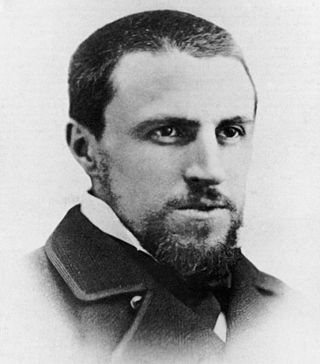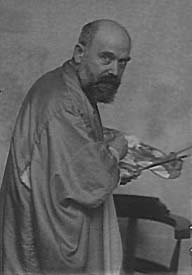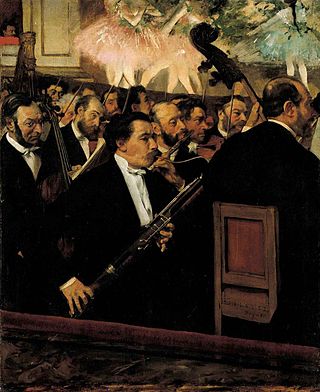
Édouard Manet was a French modernist painter. He was one of the first 19th-century artists to paint modern life, as well as a pivotal figure in the transition from Realism to Impressionism.

Impressionism was a 19th-century art movement characterized by relatively small, thin, yet visible brush strokes, open composition, emphasis on accurate depiction of light in its changing qualities, ordinary subject matter, unusual visual angles, and inclusion of movement as a crucial element of human perception and experience. Impressionism originated with a group of Paris-based artists whose independent exhibitions brought them to prominence during the 1870s and 1880s.

The Musée d'Orsay is a museum in Paris, France, on the Left Bank of the Seine. It is housed in the former Gare d'Orsay, a Beaux-Arts railway station built between 1898 and 1900. The museum holds mainly French art dating from 1848 to 1914, including paintings, sculptures, furniture, and photography. It houses the largest collection of Impressionist and post-Impressionist masterpieces in the world, by painters including Berthe Morisot, Claude Monet, Édouard Manet, Degas, Renoir, Cézanne, Seurat, Sisley, Gauguin, and van Gogh. Many of these works were held at the Galerie nationale du Jeu de Paume prior to the museum's opening in 1986. It is one of the largest art museums in Europe.

Edgar Degas was a French Impressionist artist famous for his pastel drawings and oil paintings.

Gustave Caillebotte was a French painter who was a member and patron of the Impressionists, although he painted in a more realistic manner than many others in the group. Caillebotte was known for his early interest in photography as an art form.

Portraits at the Stock Exchange is a painting by the French artist Edgar Degas. Completed in about 1879, the painting was already in the collection of the French banker Ernest May when it was listed in the catalogue of the fourth Impressionist exhibition that year. It may also have been shown in the next Impressionist exhibit in 1880, but it was not well known until it entered the collections of the Louvre in 1923. The canvas shows an interior corner of the open trading floor of the Paris Stock Exchange. May stands in the center of the picture wearing a top hat and pince-nez, listening to his colleague, a certain M. Bolâtre, leaning over his shoulder. They are likely discussing a document, possibly a bordereau, held aloft by a partially obscured third party.

Lucien Lévy-Dhurmer was a French artist and a leading exponent of fin-de-siècle Symbolism and Art Nouveau. His works include paintings, drawings, ceramics, furniture and interior design.

Vue de toits (Effet de neige) (English title: View of rooftops (Effect of snow)) is an oil painting by French impressionist Gustave Caillebotte executed in the winter of 1878 and 1879. The canvas measures 81 by 65 centimetres (32 in × 26 in). It was originally gifted by Caillebotte's brother in 1894 to the Musée du Luxembourg, then transferred to the Musée du Louvre in 1929. In 1947, it was moved to the Galerie nationale du Jeu de Paume, which held many impressionist works in France after World War II. In 1986, it was transferred again to the Musée d'Orsay in Paris, where it is currently displayed. The painting is one of the few Caillebotte works that have remained in public view since the artist's death in 1894.

The Musée Cantini is a museum in Marseille that has been open to the public since 1936. The museum specializes in modern art, especially paintings from the first half of the twentieth century.

Les raboteurs de parquet is an oil painting by French Impressionist Gustave Caillebotte. The canvas measures 102 by 146.5 centimetres. It was originally given by Caillebotte's family in 1894 to the Musée du Luxembourg, then transferred to the Musée du Louvre in 1929. In 1947, it was moved to the Galerie nationale du Jeu de Paume, and in 1986, it was transferred again to the Musée d'Orsay in Paris, where it is currently displayed.

Young Girls at the Piano is an oil-on-canvas painting by French artist Pierre-Auguste Renoir, a leading painter in the development of the Impressionist style. The painting represents his late work period (1892–1919). It was completed in 1892 as an informal commission for the Musée du Luxembourg. Renoir painted three other variations of this composition in oil and two sketches, one in oil and one in pastel. Known by the artist as repetitions, they were executed to fulfill commissions from dealers and collectors. The work is on public display at the Musée d'Orsay in Paris, Metropolitan Museum of Art in New York, and the Musée de l'Orangerie in Paris.

After the Bath, Woman Drying Herself is a pastel drawing by Edgar Degas, made between 1890 and 1895. Since 1959, it has been in the collection of the National Gallery, London. This work is one in a series of pastels and oils that Degas created depicting female nudes. Originally, Degas exhibited his works at Impressionist exhibitions in Paris, where he gained a loyal following.

Jean-Baptiste-Antoine Guillemet was a French renowned landscape painter and longtime Jury member of the Salon des Artistes Francais. He was one of the first 19th-century artists to paint modern life, and a pivotal figure in the transition from Realism to Impressionism.

Henri Michel-Lévy, was a French impressionist painter.

La Toilette, also known as Rousse, is an painting by Henri de Toulouse-Lautrec, from 1889. The painting depicts a red-headed woman, stripped to the waist, seated on the floor, facing away from the viewer, just before or just after bathing. Held by public collections in France since 1914, it has been at the Musée d'Orsay, in Paris, since 1983.
Antonin Personnaz was a French art collector and early colour photographer.

The Tub (1886) is a pastel artwork by Impressionist artist, Edgar Degas (1834–1917). It is currently housed in the Musée d'Orsay in Paris.
William Samuel Horton was an American impressionist painter who mostly painted landscapes and water scenes. He spent a large part of his life in Europe, mostly in France and England, where he trained and developed his impressionist style with major impressionist artists. He is considered by art critics, gallerists and museums to be one of the major members of American impressionism, following on painters such as Mary Cassatt and Childe Hassam, but with a production mostly centered on European motives.

The Orchestra at the Opera is an oil-on-canvas painting by the French artist Edgar Degas (1834–1917).



















